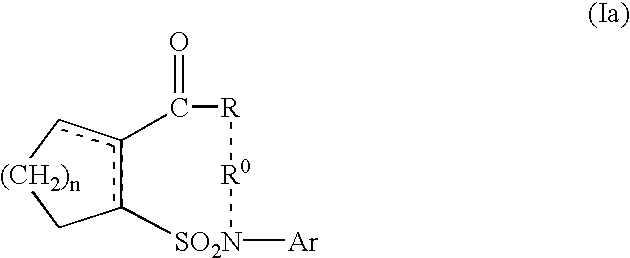Cycloalkene derivatives, process for producing the same, and use
a technology of cycloalkene and derivatives, applied in the field of cycloalkene derivatives, process for producing the same, can solve the problems of insatiable activity, cytokine production, excessive or excessive production, etc., and achieve excellent no and/or cytokine production inhibitory effect, excellent pharmaceutical properties, clinical usefulness
- Summary
- Abstract
- Description
- Claims
- Application Information
AI Technical Summary
Benefits of technology
Problems solved by technology
Method used
Image
Examples
reference example 1
Sodium peroxyborate tetrahydrate (22.3 g) was admixed with acetic acid (120 ml) and heated to 50 to 55.degree. C. and then a solution of ethyl 2-mercapto-1-cyclohexene-1-carboxylate (9.0 g) in acetic acid (15 ml) was added dropwise over 2 hours. The mixture was stirred at 50 to 55.degree. C. for 3 hours and then at 80 to 85.degree. C. for 5 hours and concentrated under reduced pressure. The residue was combined with acetonitrile (200 ml) and stirred at room temperature for 3 hours and the resultant insolubles were filtered off. The insolubles were washed with acetonitrile (50 ml) and the filtrate and the washing were combined and concentrated under reduced pressure, and the resultant residue was dissolved in acetonitrile (150 ml) and stirred at room temperature for 2 hours. The resultant insolubles were filtered off, and the filtrate was concentrated under reduced pressure. The residue was combined with diisopropyl ether (300 ml) and the powder which precipitated was isolated by fil...
reference example 2
Sodium peroxyborate tetrahydrate (74.3 g) was admixed with acetic acid (400 ml) and heated to 50 to 55.degree. C. and then a solution of ethyl 2-mercapto-1-cyclohexene-1-carboxylate (30.0 g) in acetic acid (50 ml) was added dropwise over 2 hours. The mixture was stirred at 50 to 55.degree. C. for 3 hours and then at 80 to 85.degree. C. for 5 hours and concentrated under reduced pressure. The residue was combined with acetonitrile (660 ml) and stirred at room temperature for 1 hour and the resultant insolubles were filtered off. The insolubles were washed with acetonitrile (50 ml) and the filtrate and the washing were combined and concentrated under reduced pressure, and the resultant residue was dissolved in acetonitrile (500 ml) and stirred at room temperature for 2 hours. The resultant insolubles were filtered off, and the filtrate was concentrated under reduced pressure. The residue was combined with diisopropyl ether (1000 ml) and the powder which precipitated was isolated by fi...
reference example 3
Sodium peroxyborate tetrahydrate (10.6 g) was admixed with acetic acid (57 ml) and heated to 50 to 55.degree. C. and then a solution of ethyl 2-mercapto-1-cyclopentene-1-carboxylate (3.9 g, synthesized in accordance with Tetrahedron, Vol.30, p.3753 (1974)) in acetic acid (7 ml) was added dropwise over 2 hours. The mixture was stirred at 50 to 55.degree. C. for 3 hours and then at 80 to 85.degree. C. for 5 hours and concentrated under reduced pressure. The residue was combined with acetonitrile (100 ml) and stirred at room temperature for 12 hours and the resultant insolubles were filtered off. The insolubles were washed with acetonitrile (10 ml) and the filtrate and the washing were combined and concentrated under reduced pressure, and the resultant residue was dissolved in acetonitrile (70 ml) and stirred at room temperature for 2 hours. The resultant insolubles were filtered off, and the filtrate was concentrated under reduced pressure. The residue was combined with diisopropyl et...
PUM
| Property | Measurement | Unit |
|---|---|---|
| temperature | aaaaa | aaaaa |
| temperature | aaaaa | aaaaa |
| temperature | aaaaa | aaaaa |
Abstract
Description
Claims
Application Information
 Login to View More
Login to View More - R&D
- Intellectual Property
- Life Sciences
- Materials
- Tech Scout
- Unparalleled Data Quality
- Higher Quality Content
- 60% Fewer Hallucinations
Browse by: Latest US Patents, China's latest patents, Technical Efficacy Thesaurus, Application Domain, Technology Topic, Popular Technical Reports.
© 2025 PatSnap. All rights reserved.Legal|Privacy policy|Modern Slavery Act Transparency Statement|Sitemap|About US| Contact US: help@patsnap.com



